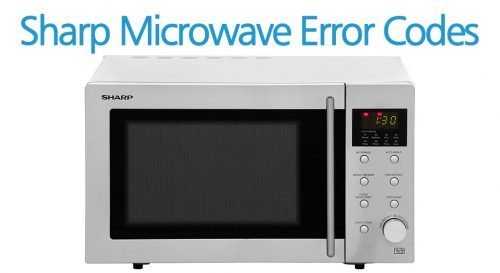
Now, let’s be honest. Seeing any error code on your microwave can be daunting. It’s like your appliance is speaking a different language, leaving you to play the guessing game. Thankfully, understanding what Error Code Ue means and learning how to prevent it isn’t as complicated as it seems. Instead of envisioning costly repairs or a complete microwave replacement, let’s delve into some practical steps to keep your Sharp microwave running smoothly.
Understanding Error Code Ue
First things first, let’s break down the mysterious “Error Code Ue.” When this code pops up on your Sharp microwave’s display, it’s often an indicator that the unit’s sensor has detected an unstable or inconsistent environment. Think of it like a car alarm that goes off when there’s a slight disturbance. The microwave’s sensor is sensitive to the conditions inside and can trigger this error if something seems off.
The sensor plays a crucial role in ensuring that your food is cooked evenly and efficiently. If it detects any moisture or steam inconsistency, it may interpret it as an error. This can happen more frequently if you’re cooking foods that release a lot of steam or if there’s a buildup of moisture inside the cavity. However, not all error code appearances mean there’s a significant problem; sometimes, it’s just the microwave being overly cautious.
You might also notice this error if there’s a sudden change in the microwave’s power supply or if it’s been running for a prolonged period without a break. This is akin to your computer overheating when you’ve been using it nonstop — sometimes, your devices just need a little pause.
Common Causes of Error Code Ue
It’s important to understand what might trigger this error code to prevent it in the future. One common cause is moisture buildup inside the microwave. Moisture can accumulate if you frequently cook foods that release a lot of steam. This might sound trivial, but even a little bit of moisture can confuse the sensors, which depend on a stable environment to function properly.
Another potential culprit could be power fluctuations. Just like any electronic device, your microwave requires a consistent power supply to operate smoothly. If there are dips or spikes in your home’s electrical supply, this can trip up the microwave’s sensors, resulting in an error code.
The age of the microwave can also be a contributing factor. Older models may not have the same advanced sensor technology found in newer appliances. As a microwave ages, its components can become less reliable, and its sensors might start misinterpreting normal conditions as anomalies, causing the error code to appear more frequently.
How to Fix Common Issues
So, what can you do if you find yourself staring down the Error Code Ue? Here’s the deal: you can try a few simple fixes before calling in a professional. Start by unplugging the microwave for a few minutes. This is like giving it a little nap — a chance to reset and clear any minor hiccups in its system. Plug it back in, and see if the error persists.
Next, check the inside for any signs of moisture or leftover residue from previous cooking sessions. Cleaning the interior thoroughly can often resolve sensor issues. Use a soft, damp cloth to wipe down the walls, ceiling, and door. Just be careful not to scrub too hard, as this might damage the surface. Once it’s clean, let it dry completely before using it again.
If power fluctuations are the issue, consider installing a surge protector, which can safeguard your microwave from unexpected electrical surges. This is akin to wearing a helmet when biking; it’s a simple step that can prevent major headaches down the road.
Preventing Future Error Code Ue Issues
Prevention is always better than cure, right? To keep Error Code Ue at bay, start by maintaining a clean microwave. Regularly wipe down the interior to prevent any moisture or residue buildup. This not only helps with sensor accuracy but also keeps your appliance smelling fresh and looking its best.
Another tip is to avoid overloading your microwave. If you’re trying to heat multiple items at once, the uneven distribution can confuse the sensors. It’s like trying to carry too many groceries — things might get dropped or go unnoticed. Instead, heat items one at a time or use shorter intervals if you must cook more than one thing simultaneously.
Additionally, be mindful of the power supply. Use a dedicated outlet for your microwave, which helps ensure it gets the consistent power it needs to function properly. This is especially important if you live in an area prone to power surges or outages.
When to Seek Professional Help
Sometimes, despite your best efforts, the error code persists. So, when should you call in a professional? If you’ve tried resetting the microwave, checked for moisture, and ensured a stable power supply, but the error persists, it might be time to seek expert assistance. Professional technicians have the tools and knowledge to diagnose and fix issues that might be beyond a simple DIY approach.
Technicians can also check the integrity of the sensors and other internal components. Sometimes, a sensor might need recalibration, or a part may require replacement. These aren’t typically things you’d want to attempt on your own, as microwaves contain high-voltage components that can be dangerous if handled improperly.
In conclusion, while Error Code Ue can seem intimidating, it’s often manageable with a few simple steps and preventative measures. Keeping your microwave clean, ensuring a steady power supply, and knowing when to call in a professional can keep your appliance running smoothly. Remember, the key is understanding and prevention, so don’t let a little error code throw you off course. Happy microwaving!